Unilever's USLP Strategy: Environment, Stakeholders, and Marketing
VerifiedAdded on 2023/01/16
|10
|2525
|44
Report
AI Summary
This report provides an in-depth analysis of Unilever's USLP (Unilever Sustainable Living Plan) strategy. It begins with an introduction to international business and Unilever, a consumer goods company. The report then explores Unilever's USLP, detailing its mission, vision, and business model, and examining the political, social, and environmental factors influencing its operations. It identifies problem areas within the USLP, such as challenges in reducing greenhouse gas emissions and changing consumer behavior. The report assesses the effectiveness of the USLP from a stakeholder perspective, highlighting benefits like profitable volume growth, cost efficiency, and innovation. Finally, it focuses on Unilever's marketing strategy, including new market channels, brand leveraging, and brand purpose initiatives, concluding with recommendations for improvement. The report emphasizes the importance of training staff to minimize environmental impact and suggests marketing strategies to attract customers.
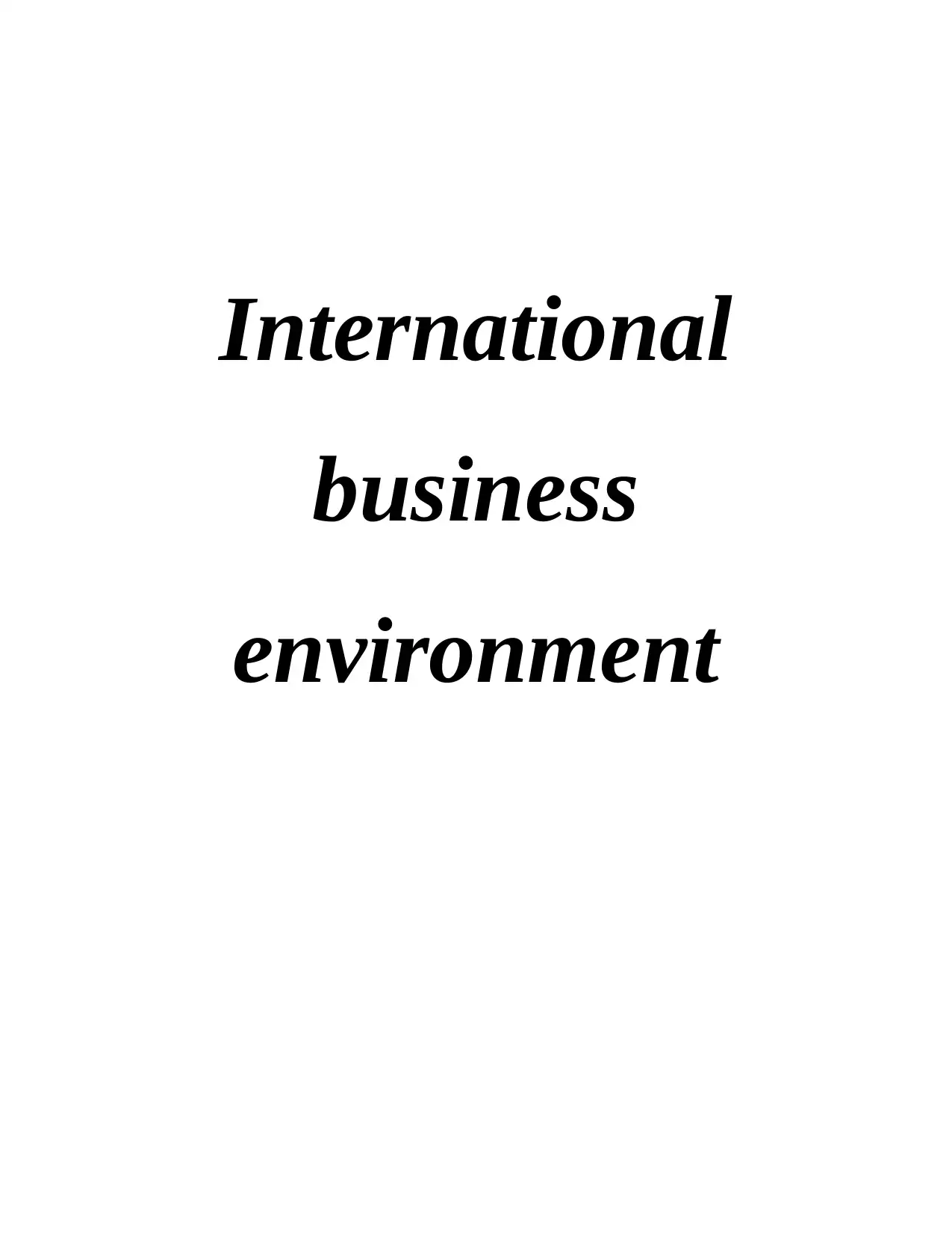
International
business
environment
business
environment
Paraphrase This Document
Need a fresh take? Get an instant paraphrase of this document with our AI Paraphraser
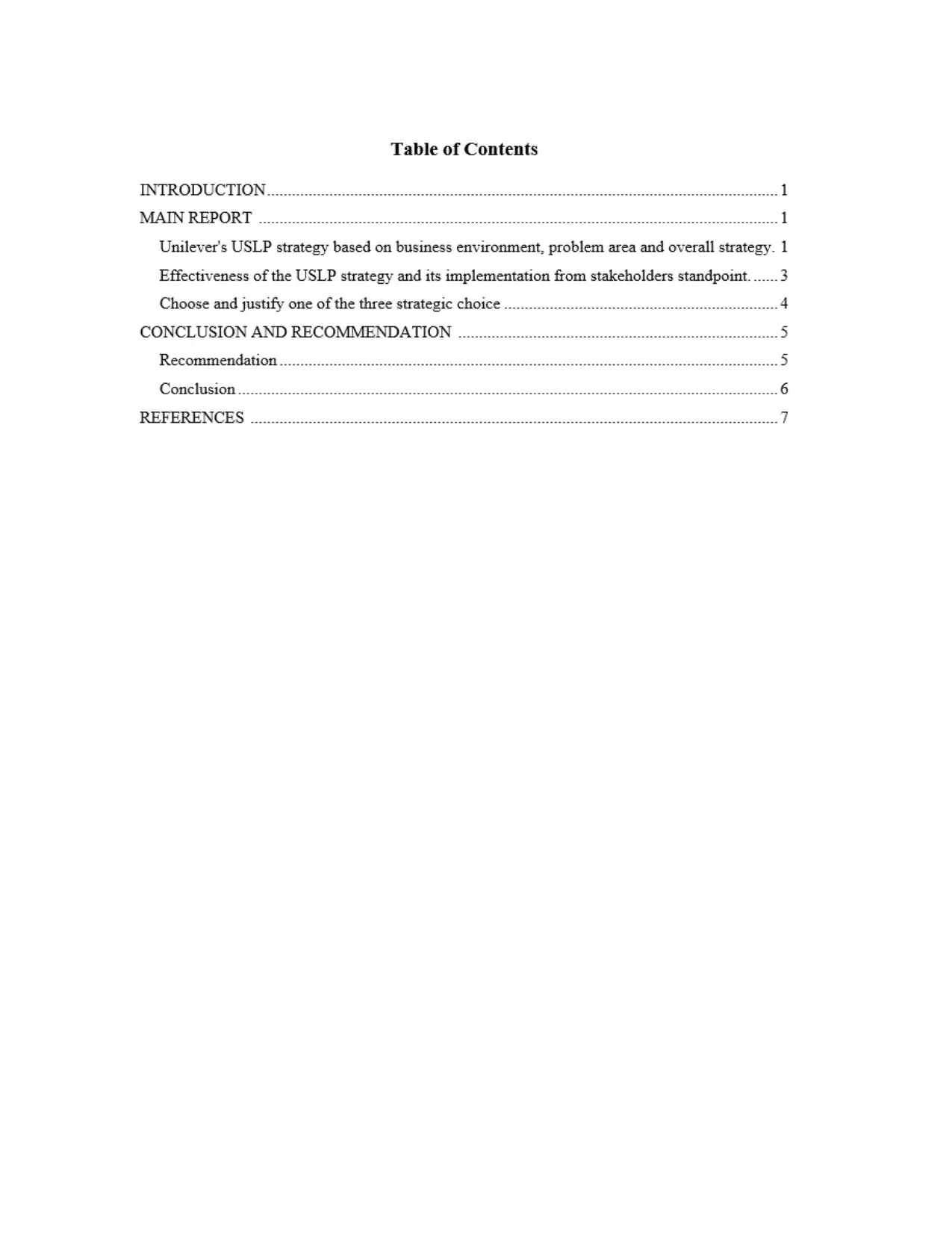

⊘ This is a preview!⊘
Do you want full access?
Subscribe today to unlock all pages.

Trusted by 1+ million students worldwide
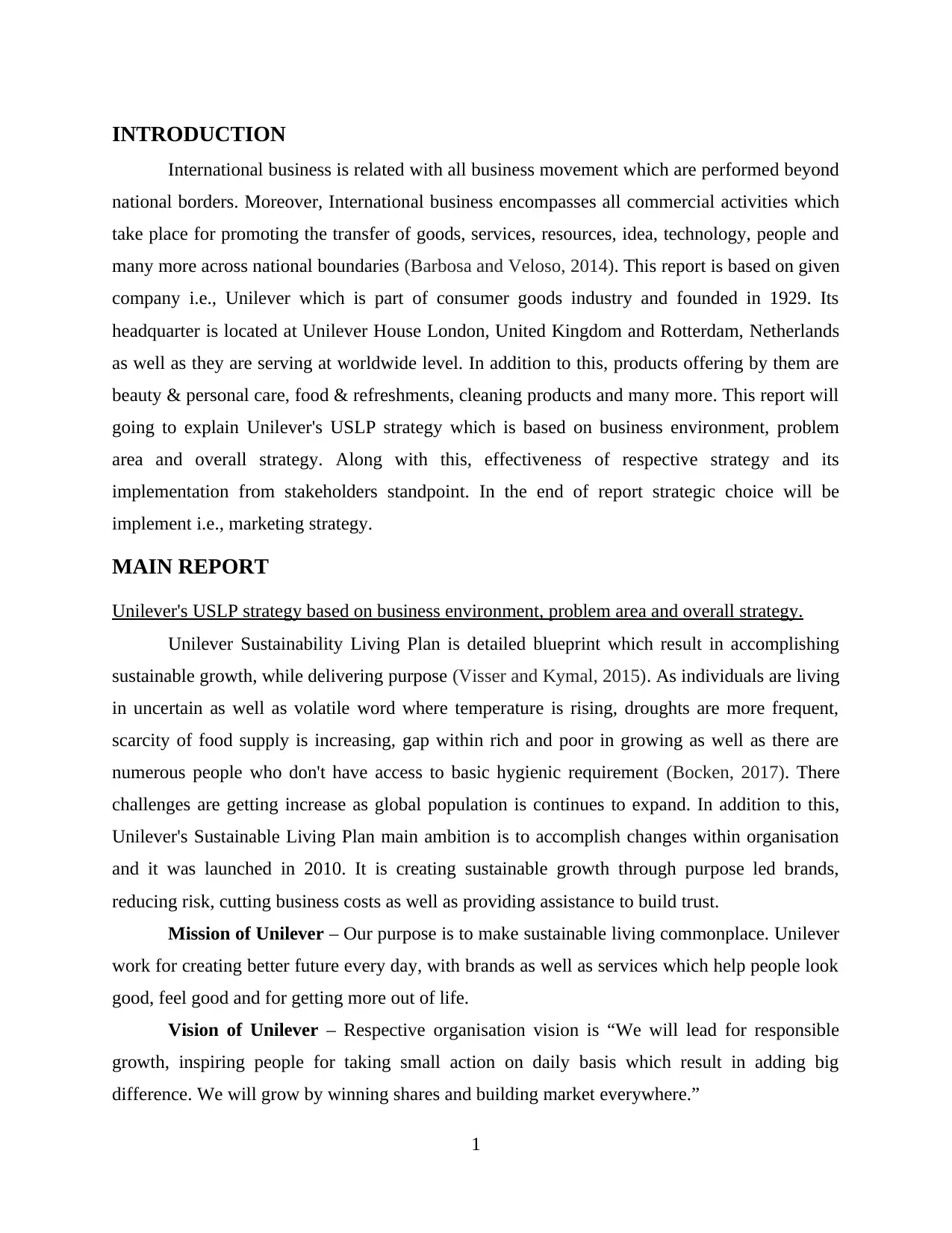
INTRODUCTION
International business is related with all business movement which are performed beyond
national borders. Moreover, International business encompasses all commercial activities which
take place for promoting the transfer of goods, services, resources, idea, technology, people and
many more across national boundaries (Barbosa and Veloso, 2014). This report is based on given
company i.e., Unilever which is part of consumer goods industry and founded in 1929. Its
headquarter is located at Unilever House London, United Kingdom and Rotterdam, Netherlands
as well as they are serving at worldwide level. In addition to this, products offering by them are
beauty & personal care, food & refreshments, cleaning products and many more. This report will
going to explain Unilever's USLP strategy which is based on business environment, problem
area and overall strategy. Along with this, effectiveness of respective strategy and its
implementation from stakeholders standpoint. In the end of report strategic choice will be
implement i.e., marketing strategy.
MAIN REPORT
Unilever's USLP strategy based on business environment, problem area and overall strategy.
Unilever Sustainability Living Plan is detailed blueprint which result in accomplishing
sustainable growth, while delivering purpose (Visser and Kymal, 2015). As individuals are living
in uncertain as well as volatile word where temperature is rising, droughts are more frequent,
scarcity of food supply is increasing, gap within rich and poor in growing as well as there are
numerous people who don't have access to basic hygienic requirement (Bocken, 2017). There
challenges are getting increase as global population is continues to expand. In addition to this,
Unilever's Sustainable Living Plan main ambition is to accomplish changes within organisation
and it was launched in 2010. It is creating sustainable growth through purpose led brands,
reducing risk, cutting business costs as well as providing assistance to build trust.
Mission of Unilever – Our purpose is to make sustainable living commonplace. Unilever
work for creating better future every day, with brands as well as services which help people look
good, feel good and for getting more out of life.
Vision of Unilever – Respective organisation vision is “We will lead for responsible
growth, inspiring people for taking small action on daily basis which result in adding big
difference. We will grow by winning shares and building market everywhere.”
1
International business is related with all business movement which are performed beyond
national borders. Moreover, International business encompasses all commercial activities which
take place for promoting the transfer of goods, services, resources, idea, technology, people and
many more across national boundaries (Barbosa and Veloso, 2014). This report is based on given
company i.e., Unilever which is part of consumer goods industry and founded in 1929. Its
headquarter is located at Unilever House London, United Kingdom and Rotterdam, Netherlands
as well as they are serving at worldwide level. In addition to this, products offering by them are
beauty & personal care, food & refreshments, cleaning products and many more. This report will
going to explain Unilever's USLP strategy which is based on business environment, problem
area and overall strategy. Along with this, effectiveness of respective strategy and its
implementation from stakeholders standpoint. In the end of report strategic choice will be
implement i.e., marketing strategy.
MAIN REPORT
Unilever's USLP strategy based on business environment, problem area and overall strategy.
Unilever Sustainability Living Plan is detailed blueprint which result in accomplishing
sustainable growth, while delivering purpose (Visser and Kymal, 2015). As individuals are living
in uncertain as well as volatile word where temperature is rising, droughts are more frequent,
scarcity of food supply is increasing, gap within rich and poor in growing as well as there are
numerous people who don't have access to basic hygienic requirement (Bocken, 2017). There
challenges are getting increase as global population is continues to expand. In addition to this,
Unilever's Sustainable Living Plan main ambition is to accomplish changes within organisation
and it was launched in 2010. It is creating sustainable growth through purpose led brands,
reducing risk, cutting business costs as well as providing assistance to build trust.
Mission of Unilever – Our purpose is to make sustainable living commonplace. Unilever
work for creating better future every day, with brands as well as services which help people look
good, feel good and for getting more out of life.
Vision of Unilever – Respective organisation vision is “We will lead for responsible
growth, inspiring people for taking small action on daily basis which result in adding big
difference. We will grow by winning shares and building market everywhere.”
1
Paraphrase This Document
Need a fresh take? Get an instant paraphrase of this document with our AI Paraphraser
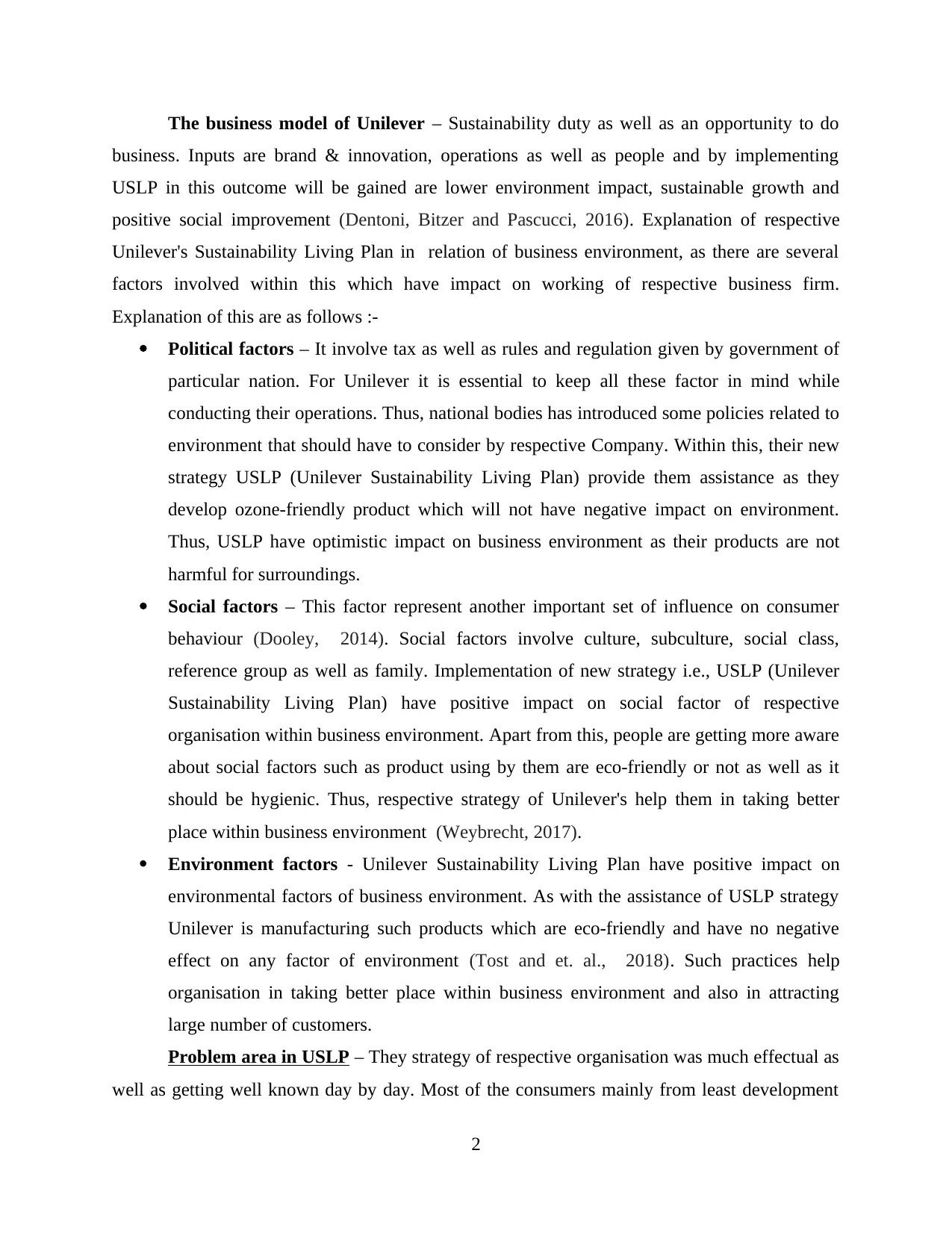
The business model of Unilever – Sustainability duty as well as an opportunity to do
business. Inputs are brand & innovation, operations as well as people and by implementing
USLP in this outcome will be gained are lower environment impact, sustainable growth and
positive social improvement (Dentoni, Bitzer and Pascucci, 2016). Explanation of respective
Unilever's Sustainability Living Plan in relation of business environment, as there are several
factors involved within this which have impact on working of respective business firm.
Explanation of this are as follows :-
Political factors – It involve tax as well as rules and regulation given by government of
particular nation. For Unilever it is essential to keep all these factor in mind while
conducting their operations. Thus, national bodies has introduced some policies related to
environment that should have to consider by respective Company. Within this, their new
strategy USLP (Unilever Sustainability Living Plan) provide them assistance as they
develop ozone-friendly product which will not have negative impact on environment.
Thus, USLP have optimistic impact on business environment as their products are not
harmful for surroundings.
Social factors – This factor represent another important set of influence on consumer
behaviour (Dooley, 2014). Social factors involve culture, subculture, social class,
reference group as well as family. Implementation of new strategy i.e., USLP (Unilever
Sustainability Living Plan) have positive impact on social factor of respective
organisation within business environment. Apart from this, people are getting more aware
about social factors such as product using by them are eco-friendly or not as well as it
should be hygienic. Thus, respective strategy of Unilever's help them in taking better
place within business environment (Weybrecht, 2017).
Environment factors - Unilever Sustainability Living Plan have positive impact on
environmental factors of business environment. As with the assistance of USLP strategy
Unilever is manufacturing such products which are eco-friendly and have no negative
effect on any factor of environment (Tost and et. al., 2018). Such practices help
organisation in taking better place within business environment and also in attracting
large number of customers.
Problem area in USLP – They strategy of respective organisation was much effectual as
well as getting well known day by day. Most of the consumers mainly from least development
2
business. Inputs are brand & innovation, operations as well as people and by implementing
USLP in this outcome will be gained are lower environment impact, sustainable growth and
positive social improvement (Dentoni, Bitzer and Pascucci, 2016). Explanation of respective
Unilever's Sustainability Living Plan in relation of business environment, as there are several
factors involved within this which have impact on working of respective business firm.
Explanation of this are as follows :-
Political factors – It involve tax as well as rules and regulation given by government of
particular nation. For Unilever it is essential to keep all these factor in mind while
conducting their operations. Thus, national bodies has introduced some policies related to
environment that should have to consider by respective Company. Within this, their new
strategy USLP (Unilever Sustainability Living Plan) provide them assistance as they
develop ozone-friendly product which will not have negative impact on environment.
Thus, USLP have optimistic impact on business environment as their products are not
harmful for surroundings.
Social factors – This factor represent another important set of influence on consumer
behaviour (Dooley, 2014). Social factors involve culture, subculture, social class,
reference group as well as family. Implementation of new strategy i.e., USLP (Unilever
Sustainability Living Plan) have positive impact on social factor of respective
organisation within business environment. Apart from this, people are getting more aware
about social factors such as product using by them are eco-friendly or not as well as it
should be hygienic. Thus, respective strategy of Unilever's help them in taking better
place within business environment (Weybrecht, 2017).
Environment factors - Unilever Sustainability Living Plan have positive impact on
environmental factors of business environment. As with the assistance of USLP strategy
Unilever is manufacturing such products which are eco-friendly and have no negative
effect on any factor of environment (Tost and et. al., 2018). Such practices help
organisation in taking better place within business environment and also in attracting
large number of customers.
Problem area in USLP – They strategy of respective organisation was much effectual as
well as getting well known day by day. Most of the consumers mainly from least development
2
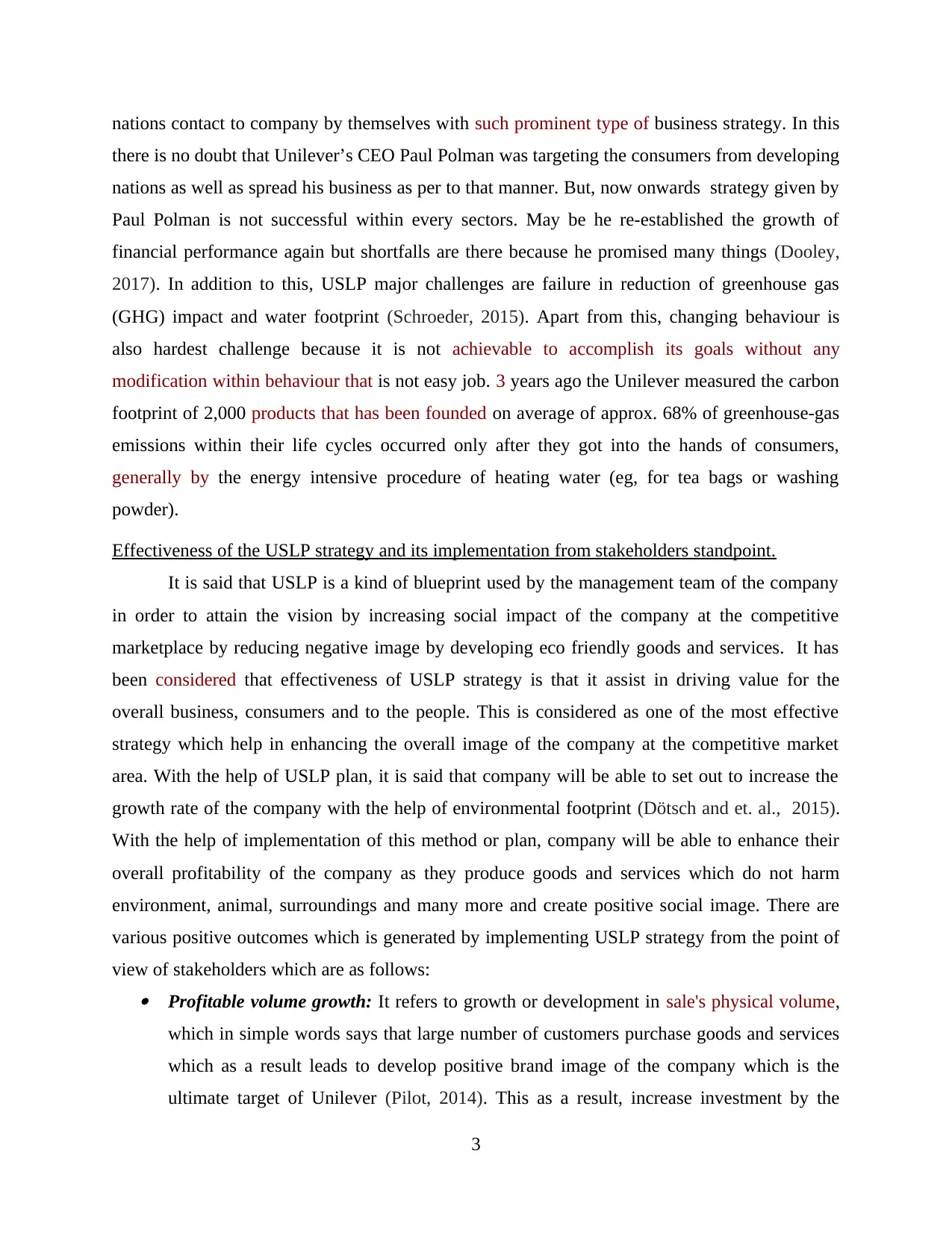
nations contact to company by themselves with such prominent type of business strategy. In this
there is no doubt that Unilever’s CEO Paul Polman was targeting the consumers from developing
nations as well as spread his business as per to that manner. But, now onwards strategy given by
Paul Polman is not successful within every sectors. May be he re-established the growth of
financial performance again but shortfalls are there because he promised many things (Dooley,
2017). In addition to this, USLP major challenges are failure in reduction of greenhouse gas
(GHG) impact and water footprint (Schroeder, 2015). Apart from this, changing behaviour is
also hardest challenge because it is not achievable to accomplish its goals without any
modification within behaviour that is not easy job. 3 years ago the Unilever measured the carbon
footprint of 2,000 products that has been founded on average of approx. 68% of greenhouse-gas
emissions within their life cycles occurred only after they got into the hands of consumers,
generally by the energy intensive procedure of heating water (eg, for tea bags or washing
powder).
Effectiveness of the USLP strategy and its implementation from stakeholders standpoint.
It is said that USLP is a kind of blueprint used by the management team of the company
in order to attain the vision by increasing social impact of the company at the competitive
marketplace by reducing negative image by developing eco friendly goods and services. It has
been considered that effectiveness of USLP strategy is that it assist in driving value for the
overall business, consumers and to the people. This is considered as one of the most effective
strategy which help in enhancing the overall image of the company at the competitive market
area. With the help of USLP plan, it is said that company will be able to set out to increase the
growth rate of the company with the help of environmental footprint (Dötsch and et. al., 2015).
With the help of implementation of this method or plan, company will be able to enhance their
overall profitability of the company as they produce goods and services which do not harm
environment, animal, surroundings and many more and create positive social image. There are
various positive outcomes which is generated by implementing USLP strategy from the point of
view of stakeholders which are as follows: Profitable volume growth: It refers to growth or development in sale's physical volume,
which in simple words says that large number of customers purchase goods and services
which as a result leads to develop positive brand image of the company which is the
ultimate target of Unilever (Pilot, 2014). This as a result, increase investment by the
3
there is no doubt that Unilever’s CEO Paul Polman was targeting the consumers from developing
nations as well as spread his business as per to that manner. But, now onwards strategy given by
Paul Polman is not successful within every sectors. May be he re-established the growth of
financial performance again but shortfalls are there because he promised many things (Dooley,
2017). In addition to this, USLP major challenges are failure in reduction of greenhouse gas
(GHG) impact and water footprint (Schroeder, 2015). Apart from this, changing behaviour is
also hardest challenge because it is not achievable to accomplish its goals without any
modification within behaviour that is not easy job. 3 years ago the Unilever measured the carbon
footprint of 2,000 products that has been founded on average of approx. 68% of greenhouse-gas
emissions within their life cycles occurred only after they got into the hands of consumers,
generally by the energy intensive procedure of heating water (eg, for tea bags or washing
powder).
Effectiveness of the USLP strategy and its implementation from stakeholders standpoint.
It is said that USLP is a kind of blueprint used by the management team of the company
in order to attain the vision by increasing social impact of the company at the competitive
marketplace by reducing negative image by developing eco friendly goods and services. It has
been considered that effectiveness of USLP strategy is that it assist in driving value for the
overall business, consumers and to the people. This is considered as one of the most effective
strategy which help in enhancing the overall image of the company at the competitive market
area. With the help of USLP plan, it is said that company will be able to set out to increase the
growth rate of the company with the help of environmental footprint (Dötsch and et. al., 2015).
With the help of implementation of this method or plan, company will be able to enhance their
overall profitability of the company as they produce goods and services which do not harm
environment, animal, surroundings and many more and create positive social image. There are
various positive outcomes which is generated by implementing USLP strategy from the point of
view of stakeholders which are as follows: Profitable volume growth: It refers to growth or development in sale's physical volume,
which in simple words says that large number of customers purchase goods and services
which as a result leads to develop positive brand image of the company which is the
ultimate target of Unilever (Pilot, 2014). This as a result, increase investment by the
3
⊘ This is a preview!⊘
Do you want full access?
Subscribe today to unlock all pages.

Trusted by 1+ million students worldwide
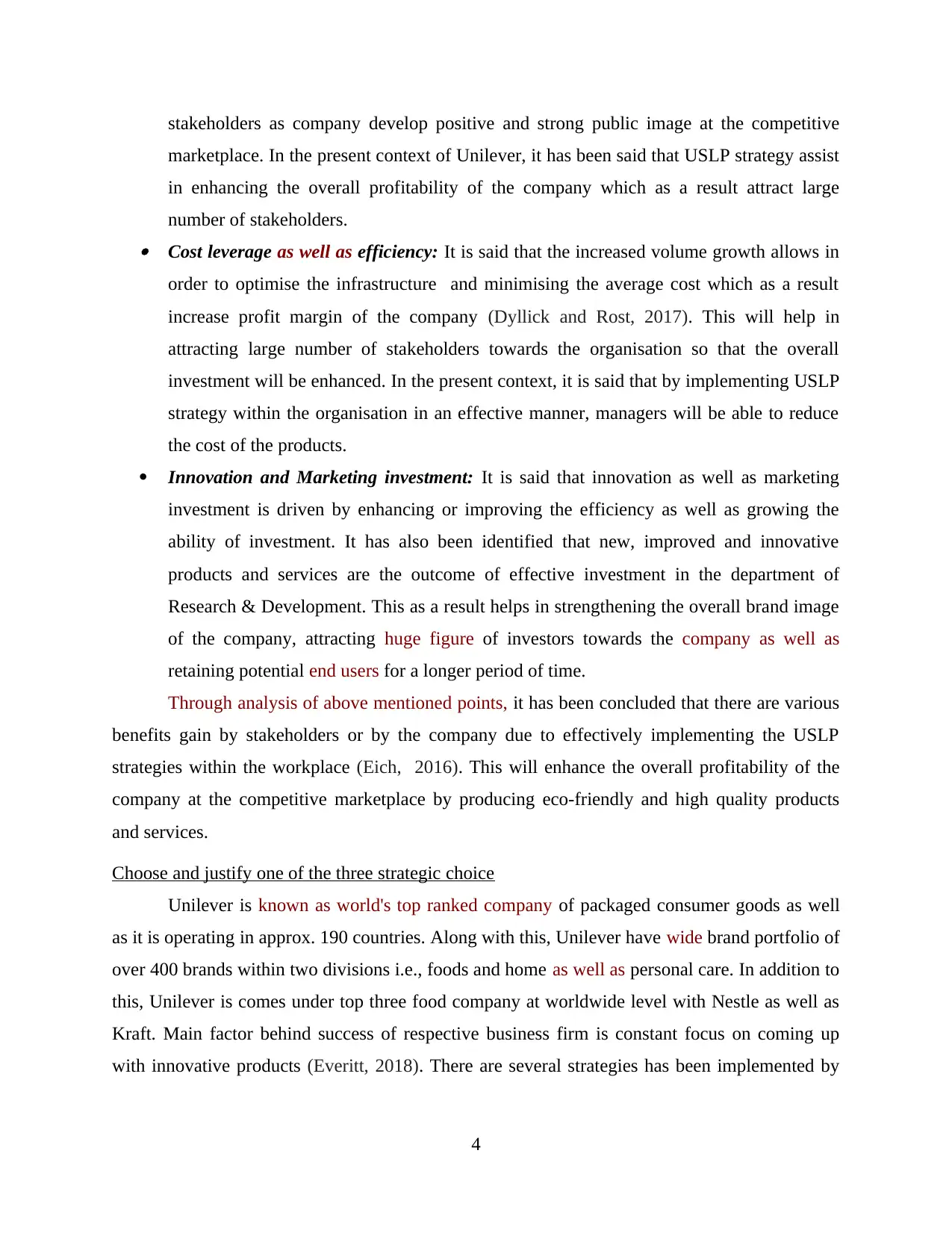
stakeholders as company develop positive and strong public image at the competitive
marketplace. In the present context of Unilever, it has been said that USLP strategy assist
in enhancing the overall profitability of the company which as a result attract large
number of stakeholders. Cost leverage as well as efficiency: It is said that the increased volume growth allows in
order to optimise the infrastructure and minimising the average cost which as a result
increase profit margin of the company (Dyllick and Rost, 2017). This will help in
attracting large number of stakeholders towards the organisation so that the overall
investment will be enhanced. In the present context, it is said that by implementing USLP
strategy within the organisation in an effective manner, managers will be able to reduce
the cost of the products.
Innovation and Marketing investment: It is said that innovation as well as marketing
investment is driven by enhancing or improving the efficiency as well as growing the
ability of investment. It has also been identified that new, improved and innovative
products and services are the outcome of effective investment in the department of
Research & Development. This as a result helps in strengthening the overall brand image
of the company, attracting huge figure of investors towards the company as well as
retaining potential end users for a longer period of time.
Through analysis of above mentioned points, it has been concluded that there are various
benefits gain by stakeholders or by the company due to effectively implementing the USLP
strategies within the workplace (Eich, 2016). This will enhance the overall profitability of the
company at the competitive marketplace by producing eco-friendly and high quality products
and services.
Choose and justify one of the three strategic choice
Unilever is known as world's top ranked company of packaged consumer goods as well
as it is operating in approx. 190 countries. Along with this, Unilever have wide brand portfolio of
over 400 brands within two divisions i.e., foods and home as well as personal care. In addition to
this, Unilever is comes under top three food company at worldwide level with Nestle as well as
Kraft. Main factor behind success of respective business firm is constant focus on coming up
with innovative products (Everitt, 2018). There are several strategies has been implemented by
4
marketplace. In the present context of Unilever, it has been said that USLP strategy assist
in enhancing the overall profitability of the company which as a result attract large
number of stakeholders. Cost leverage as well as efficiency: It is said that the increased volume growth allows in
order to optimise the infrastructure and minimising the average cost which as a result
increase profit margin of the company (Dyllick and Rost, 2017). This will help in
attracting large number of stakeholders towards the organisation so that the overall
investment will be enhanced. In the present context, it is said that by implementing USLP
strategy within the organisation in an effective manner, managers will be able to reduce
the cost of the products.
Innovation and Marketing investment: It is said that innovation as well as marketing
investment is driven by enhancing or improving the efficiency as well as growing the
ability of investment. It has also been identified that new, improved and innovative
products and services are the outcome of effective investment in the department of
Research & Development. This as a result helps in strengthening the overall brand image
of the company, attracting huge figure of investors towards the company as well as
retaining potential end users for a longer period of time.
Through analysis of above mentioned points, it has been concluded that there are various
benefits gain by stakeholders or by the company due to effectively implementing the USLP
strategies within the workplace (Eich, 2016). This will enhance the overall profitability of the
company at the competitive marketplace by producing eco-friendly and high quality products
and services.
Choose and justify one of the three strategic choice
Unilever is known as world's top ranked company of packaged consumer goods as well
as it is operating in approx. 190 countries. Along with this, Unilever have wide brand portfolio of
over 400 brands within two divisions i.e., foods and home as well as personal care. In addition to
this, Unilever is comes under top three food company at worldwide level with Nestle as well as
Kraft. Main factor behind success of respective business firm is constant focus on coming up
with innovative products (Everitt, 2018). There are several strategies has been implemented by
4
Paraphrase This Document
Need a fresh take? Get an instant paraphrase of this document with our AI Paraphraser
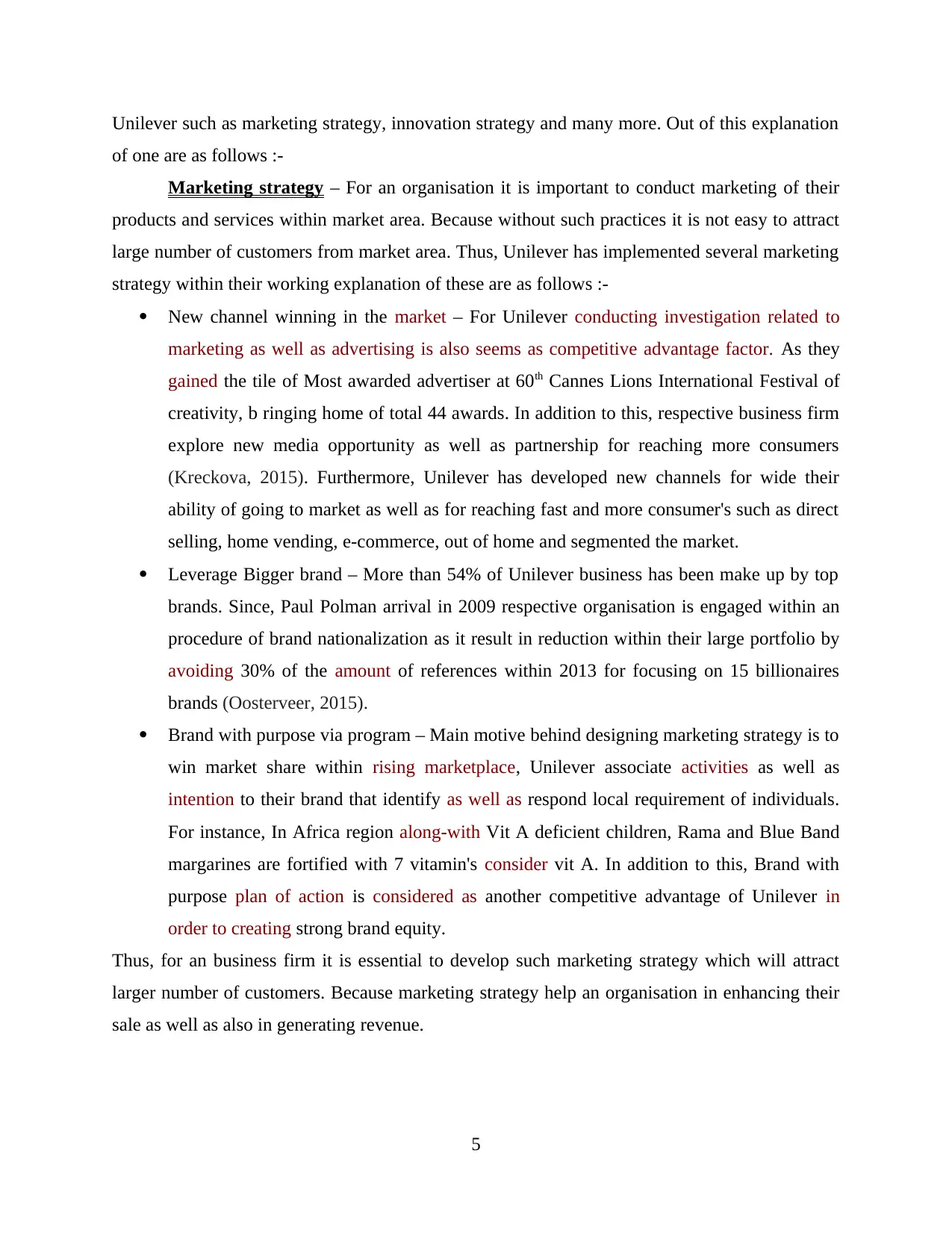
Unilever such as marketing strategy, innovation strategy and many more. Out of this explanation
of one are as follows :-
Marketing strategy – For an organisation it is important to conduct marketing of their
products and services within market area. Because without such practices it is not easy to attract
large number of customers from market area. Thus, Unilever has implemented several marketing
strategy within their working explanation of these are as follows :-
New channel winning in the market – For Unilever conducting investigation related to
marketing as well as advertising is also seems as competitive advantage factor. As they
gained the tile of Most awarded advertiser at 60th Cannes Lions International Festival of
creativity, b ringing home of total 44 awards. In addition to this, respective business firm
explore new media opportunity as well as partnership for reaching more consumers
(Kreckova, 2015). Furthermore, Unilever has developed new channels for wide their
ability of going to market as well as for reaching fast and more consumer's such as direct
selling, home vending, e-commerce, out of home and segmented the market.
Leverage Bigger brand – More than 54% of Unilever business has been make up by top
brands. Since, Paul Polman arrival in 2009 respective organisation is engaged within an
procedure of brand nationalization as it result in reduction within their large portfolio by
avoiding 30% of the amount of references within 2013 for focusing on 15 billionaires
brands (Oosterveer, 2015).
Brand with purpose via program – Main motive behind designing marketing strategy is to
win market share within rising marketplace, Unilever associate activities as well as
intention to their brand that identify as well as respond local requirement of individuals.
For instance, In Africa region along-with Vit A deficient children, Rama and Blue Band
margarines are fortified with 7 vitamin's consider vit A. In addition to this, Brand with
purpose plan of action is considered as another competitive advantage of Unilever in
order to creating strong brand equity.
Thus, for an business firm it is essential to develop such marketing strategy which will attract
larger number of customers. Because marketing strategy help an organisation in enhancing their
sale as well as also in generating revenue.
5
of one are as follows :-
Marketing strategy – For an organisation it is important to conduct marketing of their
products and services within market area. Because without such practices it is not easy to attract
large number of customers from market area. Thus, Unilever has implemented several marketing
strategy within their working explanation of these are as follows :-
New channel winning in the market – For Unilever conducting investigation related to
marketing as well as advertising is also seems as competitive advantage factor. As they
gained the tile of Most awarded advertiser at 60th Cannes Lions International Festival of
creativity, b ringing home of total 44 awards. In addition to this, respective business firm
explore new media opportunity as well as partnership for reaching more consumers
(Kreckova, 2015). Furthermore, Unilever has developed new channels for wide their
ability of going to market as well as for reaching fast and more consumer's such as direct
selling, home vending, e-commerce, out of home and segmented the market.
Leverage Bigger brand – More than 54% of Unilever business has been make up by top
brands. Since, Paul Polman arrival in 2009 respective organisation is engaged within an
procedure of brand nationalization as it result in reduction within their large portfolio by
avoiding 30% of the amount of references within 2013 for focusing on 15 billionaires
brands (Oosterveer, 2015).
Brand with purpose via program – Main motive behind designing marketing strategy is to
win market share within rising marketplace, Unilever associate activities as well as
intention to their brand that identify as well as respond local requirement of individuals.
For instance, In Africa region along-with Vit A deficient children, Rama and Blue Band
margarines are fortified with 7 vitamin's consider vit A. In addition to this, Brand with
purpose plan of action is considered as another competitive advantage of Unilever in
order to creating strong brand equity.
Thus, for an business firm it is essential to develop such marketing strategy which will attract
larger number of customers. Because marketing strategy help an organisation in enhancing their
sale as well as also in generating revenue.
5
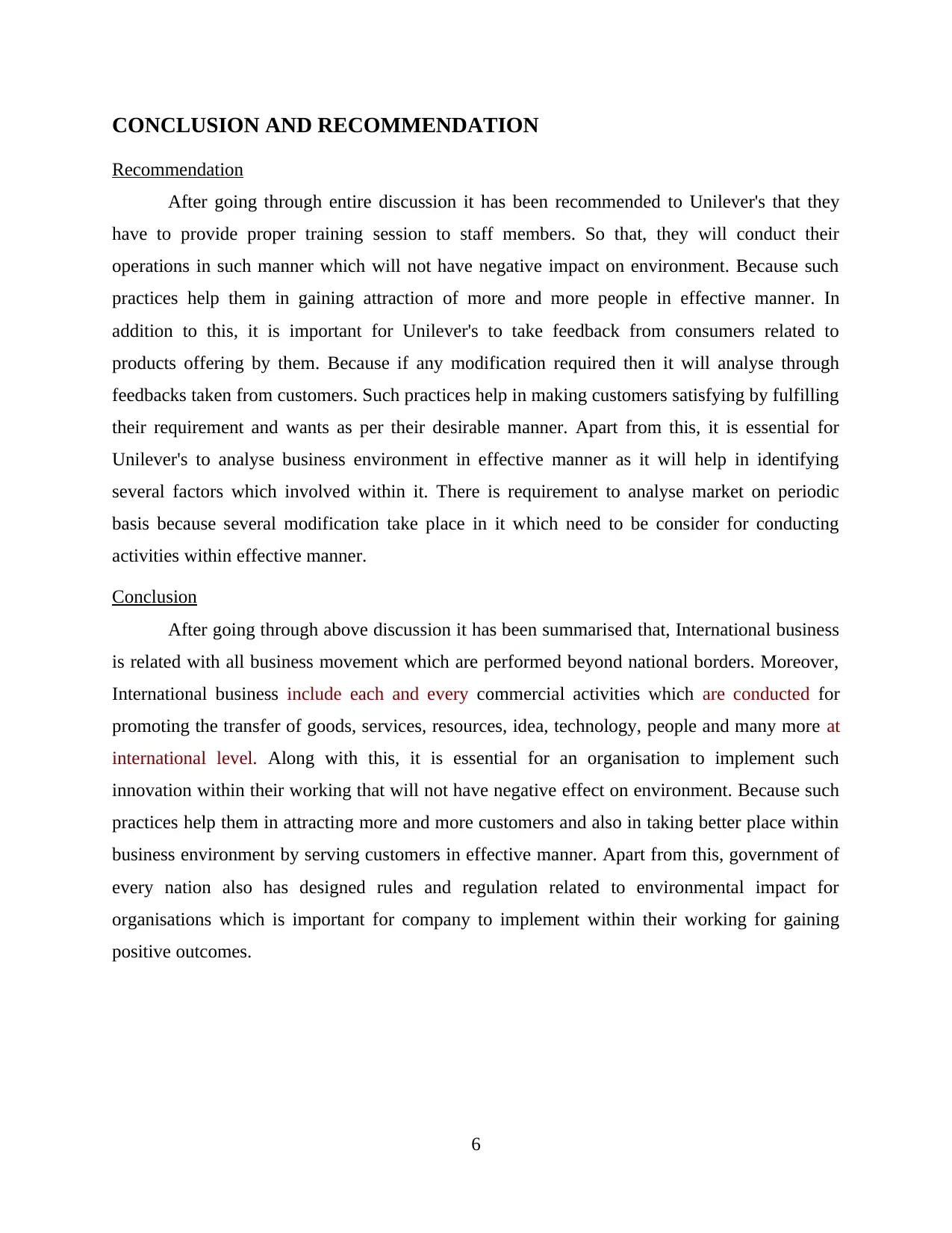
CONCLUSION AND RECOMMENDATION
Recommendation
After going through entire discussion it has been recommended to Unilever's that they
have to provide proper training session to staff members. So that, they will conduct their
operations in such manner which will not have negative impact on environment. Because such
practices help them in gaining attraction of more and more people in effective manner. In
addition to this, it is important for Unilever's to take feedback from consumers related to
products offering by them. Because if any modification required then it will analyse through
feedbacks taken from customers. Such practices help in making customers satisfying by fulfilling
their requirement and wants as per their desirable manner. Apart from this, it is essential for
Unilever's to analyse business environment in effective manner as it will help in identifying
several factors which involved within it. There is requirement to analyse market on periodic
basis because several modification take place in it which need to be consider for conducting
activities within effective manner.
Conclusion
After going through above discussion it has been summarised that, International business
is related with all business movement which are performed beyond national borders. Moreover,
International business include each and every commercial activities which are conducted for
promoting the transfer of goods, services, resources, idea, technology, people and many more at
international level. Along with this, it is essential for an organisation to implement such
innovation within their working that will not have negative effect on environment. Because such
practices help them in attracting more and more customers and also in taking better place within
business environment by serving customers in effective manner. Apart from this, government of
every nation also has designed rules and regulation related to environmental impact for
organisations which is important for company to implement within their working for gaining
positive outcomes.
6
Recommendation
After going through entire discussion it has been recommended to Unilever's that they
have to provide proper training session to staff members. So that, they will conduct their
operations in such manner which will not have negative impact on environment. Because such
practices help them in gaining attraction of more and more people in effective manner. In
addition to this, it is important for Unilever's to take feedback from consumers related to
products offering by them. Because if any modification required then it will analyse through
feedbacks taken from customers. Such practices help in making customers satisfying by fulfilling
their requirement and wants as per their desirable manner. Apart from this, it is essential for
Unilever's to analyse business environment in effective manner as it will help in identifying
several factors which involved within it. There is requirement to analyse market on periodic
basis because several modification take place in it which need to be consider for conducting
activities within effective manner.
Conclusion
After going through above discussion it has been summarised that, International business
is related with all business movement which are performed beyond national borders. Moreover,
International business include each and every commercial activities which are conducted for
promoting the transfer of goods, services, resources, idea, technology, people and many more at
international level. Along with this, it is essential for an organisation to implement such
innovation within their working that will not have negative effect on environment. Because such
practices help them in attracting more and more customers and also in taking better place within
business environment by serving customers in effective manner. Apart from this, government of
every nation also has designed rules and regulation related to environmental impact for
organisations which is important for company to implement within their working for gaining
positive outcomes.
6
⊘ This is a preview!⊘
Do you want full access?
Subscribe today to unlock all pages.

Trusted by 1+ million students worldwide
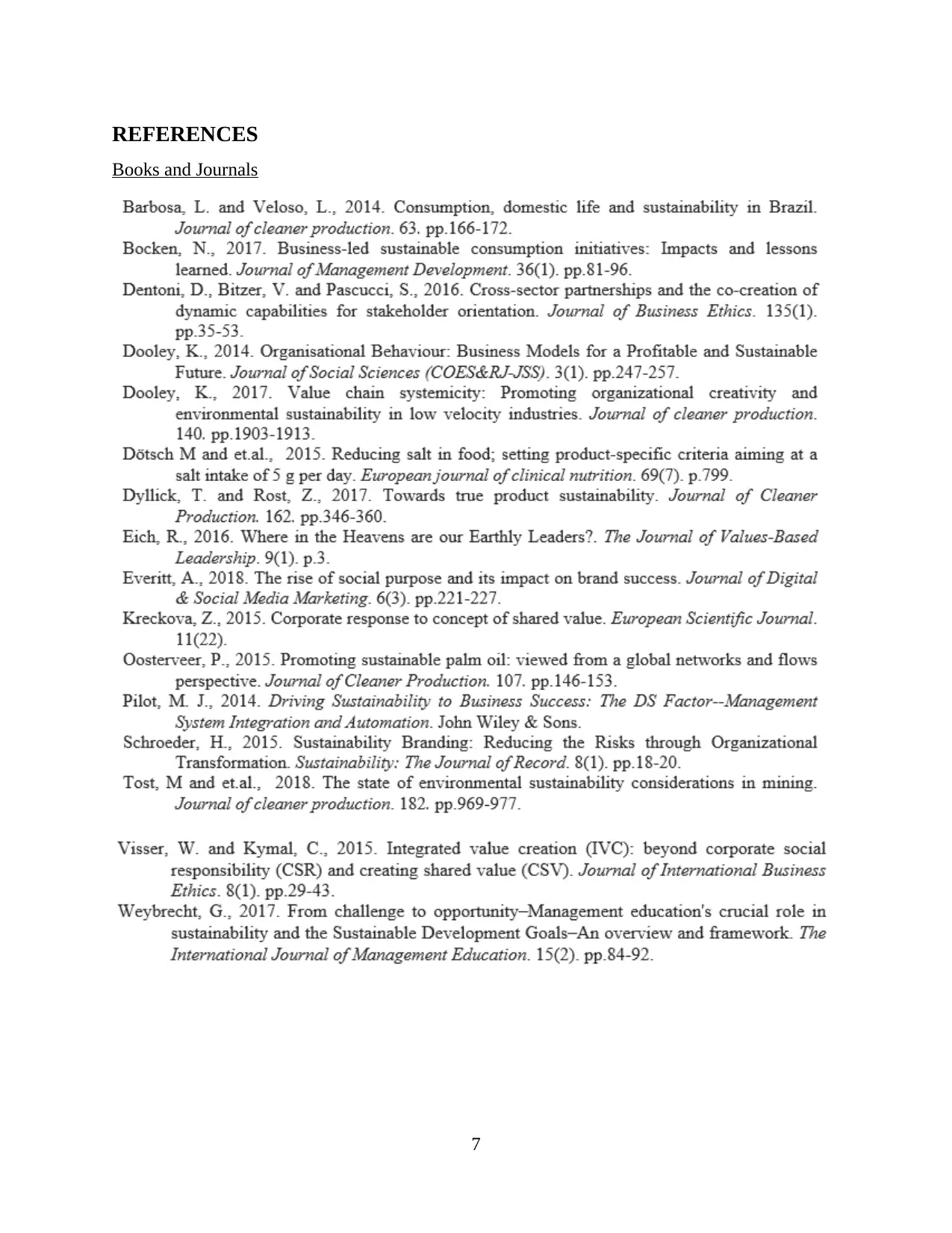
REFERENCES
Books and Journals
7
Books and Journals
7
1 out of 10
Related Documents
Your All-in-One AI-Powered Toolkit for Academic Success.
+13062052269
info@desklib.com
Available 24*7 on WhatsApp / Email
![[object Object]](/_next/static/media/star-bottom.7253800d.svg)
Unlock your academic potential
Copyright © 2020–2025 A2Z Services. All Rights Reserved. Developed and managed by ZUCOL.





